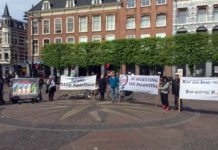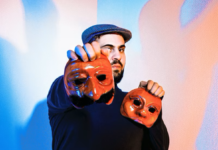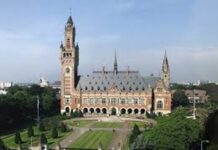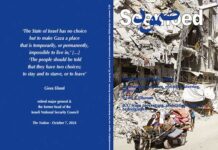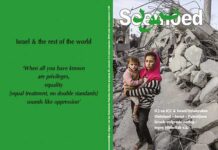Oneg Ben Dror
Jewish Currents / March 28, 2025
For the loved ones of some Palestinian captives, the short-lived ceasefire offered a painful road to reunion.
On the rainy morning of Saturday, February 22nd, a crowd gathered near the Ramallah Cultural Palace, a building that typically hosts musical performances and movie screenings, but was now being used as the reception area for Palestinians released from Israeli prisons under the Israel–Hamas ceasefire. Journalists and broadcasters, mainly from Arabic-language news outlets, gathered on the steps outside the building, clutching umbrellas, adjusting microphones, and speculating about the exact timing of the release. Inside, the atmosphere was akin to an airport arrivals hall. Friends and supporters milled around the entrance, while family members sat in a circle of cream-colored plastic chairs further inside, waiting in anticipation. As an activist focusing on the rights of Palestinians held in Israeli prisons, I had come to Ramallah to support these families, and to witness the moments of reunion and liberation that are so rare for a community facing constant incarceration and separation.
Though the Israeli government had given no official information about exactly who would be released that day, rumours about the names that were likely to be on the list had circulated, and relatives had made their way to Ramallah from all over the West Bank—Hebron and Bethlehem in the south and Jenin and Nablus in the north—traveling hours through checkpoints and blockades in the hope that it would be their loved one stepping down from the Red Cross buses. By 10 am, hundreds had gathered in the Cultural Palace’s main hall, and the excitement was palpable. People stared into their phones, riveted by the broadcast of Hamas handing over six Israeli hostages to the Red Cross in Gaza. And about two hours later, Israel finally released the list of 620 Palestinians to be released in exchange for those six Israelis.
The deal under which the exchange was carried out has been referred to as a “hostage–prisoner swap,” but in reality, most of the Palestinians on the release list that day were also hostages: people whom Israel had detained unlawfully and without trial for years, and whom it was now using as negotiating chips. (Even those who had a trial were tried under a separate system reserved for Palestinians, with a conviction rate of 99.7%). In fact, a majority of those to be released that day—469 people, including 23 children and adolescents—were abductees from Gaza, some kidnapped by the Israeli army in the years prior, but most snatched from homes, shelters, hospitals, and off the streets during the long months of Israel’s genocidal assault. Now, they would be returning to what remained of their families after over a year of relentless bombardment. Nearly 100 others, including Nael Barghouti, Israel’s longest-held Palestinian political prisoner, would be deported from Palestine altogether. After 45 years in Israeli jails, Barghouti was to be exiled to Egypt immediately after his release, while his family had been denied permission to cross the border to meet him.
For those families in the Cultural Palace whose loved ones were returning to them, the coming moment was thus as precious as it was rare. As the names of those slated to arrive spread through the room, congratulations flowed. People made phone calls to share the good news; some took pictures of the joyful scenes. Soon, a group of young men formed a circle in the middle of the room and started chanting, “We will pave your way home with roses and jasmine!” But as the time passed without more news, these celebrations died down, relief and excitement inexorably turning to unease. Why had the release time not been announced? What was the hold up? The hours passed without an answer, punctuated only by volunteers distributing cups of tea and coffee to sustain the waiting families; people leaving to pray in one of the room’s corners; and media teams interviewing people as they left and entered the building, asking the same questions over and over again: “Who are you waiting for? How long has it been? How do you feel?”
In the afternoon, things took a turn. The Israeli government announced that it would delay the release until after a cabinet meeting at 8 pm. Upon hearing of this delay, the crowd began to thin. They would return, some promised. But M., a woman of about 35 or so, dressed for the occasion in an elegant dress and matching hijab, told me that she was not going anywhere: She had been waiting for her cousin for 20 years, and she would continue to wait for as long as it took to greet the 37-year-old man whom she last saw when he was a 17-year-old child. On the news, we saw a similar scene from Khan Younis in Gaza, where Najat al-Agha, a 75-year-old mother, told journalists of her 33 year wait for the release of her son Diaa: a wait made up of endless sit-ins and speeches advocating for his release, undertaken despite the constant fear that she would die before seeing him again. Doing support work with incarcerated Palestinian’ families, I have often seen this type of resistant steadfastness, known in Arabic as “saber”, a word that also refers to a local cactus variety. Much as that cactus survives in harsh conditions and with little water, so do Palestinians persist: with a patience—a hope—that does not permit giving up, no matter the wait or the price. And now, it seemed that the hoped-for moment was finally here. “If my heart were made of iron,” Al-Agha told the BBC, “it would have melted and shattered.”
As 8 pm rolled around, the hall in Ramallah began to fill as people returned from a few hours’ reprieve, some dressed festively, others holding bouquets of flowers for their impending reunions. The mood turned celebratory again, with people from nearby neighbourhoods bringing falafel sandwiches, bottles of water, and hot drinks for those waiting. A live broadcast from outside Ofer Prison—the place from which those being released were supposed to set off—played on many cell phones as people sought any sign of the Red Cross buses that would transport their loved ones to Ramallah. No sign appeared, however. Groups of relatives gathered, talking, trying to find out what was going on. A., who sat next to me on the floor, guessed that Israel would release the detainees before midnight to avoid violating the ceasefire deal again, but midnight came and went without any change. The excitement in the room again turned to weariness. A few families with young children left, along with some of the journalists. Some of those who remained moved back and forth between the hall and the doorway, smoking cigarettes in the chilly night before returning indoors. Others remained seated, trying to warm themselves while watching for any faint movement in the feed from Ofer.
Around 2 am, they finally saw it: a flurry of activity as military jeeps and police cars left the prison. News broadcasts began to report that the buses with the detainees would soon depart. A few minutes later, though, media reports changed. It was announced that, in retaliation for the “provocative” manner in which Hamas had carried out its side of the release, the Israeli government had decided—in violation of the ceasefire agreement—to delay the release of the 620 Palestinians.
I looked at the people waiting beside me: Their faces had fallen, and some struggled to hide their tears. I later read an interview where Al-Agha, the elderly mother in Gaza, described this same moment from Khan Younis. “I saw people crying, whispering,” she said when explaining how she found out about the delay. “My children huddled together, and I heard: ‘No, not today.’ I grabbed my daughter Ola: ‘Tell me what’s happening. What does ‘no’ mean?’” Her children tried to calm her, but Al-Agha, in her grief, lost consciousness. “Are we just pawns to them?” she later said, recounting her shattered hopes. “Thirty-three years of waiting, isn’t that enough?” But it wasn’t enough. Under occupation, Palestinians have been, and remain, all too familiar with waiting: hours to pass through a checkpoint on the way to work, days or weeks for a permit to harvest their own olives, months or years to access medical care, and, as with some in the Cultural Palace that day, decades not knowing if they would ever see their child, or spouse, or sibling again.
I thought, too, of the painful waiting of those who were about to be released that day—who had spent the day being transferred between three different detention facilities and waiting for long hours in freezing prison vehicles. Throughout, they were humiliated and beaten, threatened by prison guards and intelligence officers. Many were forced to wear T-shirts with vengeful quotations from Jewish texts, and wristbands decorated with Israeli flags and the words “the eternal nation does not forget.” This ordeal ended with being sent back to the very torture camps where they had started—places where starvation and abuse are rampant, medical care is regularly denied, and over 70 Palestinians have been killed in Israeli custody since October 2023.
After the release was delayed, people began to trickle out of the Cultural Palace. Those who came from outside Ramallah started looking for places to stay for the night, hoping their loved ones would be freed the next day. But the release didn’t happen the following day, or in the days after that. It was almost a week later, on Thursday, February 26th, that the 620 Palestinians were finally released. I didn’t manage to make it to Ramallah that day, but I saw videos of the joyous, heartwarming reunions from what would come to be the final release before Israel decisively broke the ceasefire in the following weeks. Seeing the videos of the release, I thought of M., of A., and of Al-Agha, and the relief of their long waits finally ending. But I thought too of the thousands of Palestinian hostage families who did not get such a moment of liberation. For them, only saber is left, a vigil of steadfast waiting to be undertaken in the face of dire uncertainty. How many of their loved ones will be tortured in captivity; how many starved, beaten, and humiliated? Will there ever be another deal that could lead to their release? And even if that day comes, how many will live to see it?
Oneg Ben Dror is an anti-Zionist activist who works to provide support to Palestinian detainees; she has written many reports on incarceration in Israel/Palestine


